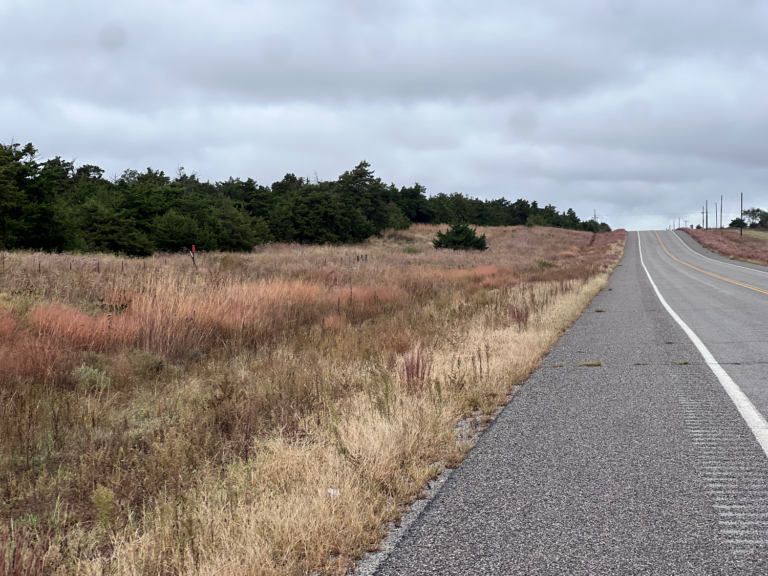Back when Kelly Roberts was a kid during the 1970s, her family would scout their northeastern Oklahoma pasture every year, looking for the perfect eastern redcedar for their Christmas tree.
“I remember traipsing across the pasture and there were very few,” Roberts said. “So we would have to walk a while before we would find one and then rule it out or rule it in.”
Fifty years later, it’s a different story.
Eastern redcedars have crept across the Great Plains, carpeting what used to be grassland from the Texas, up through Oklahoma, Kansas and Nebraska.
In some places, the redcedars have been welcomed. People plant them as windbreaks or snow fences, partly because they grow so readily and require little care. But the resilience that makes them useful can also cause problems.
Roberts especially worries about how much water the trees use.
“It’s 1.5 billion gallons of water a day — that’s what our trees are drinking,” she said. “It’s almost like you have a really nice smelling deep green sponge layer all over the state.”
‘This green dust bowl’
Redcedars aren’t necessarily thirstier than other trees, but they’re extremely drought tolerant. That means they often slurp up water in places where it’s scarcest.
The trees’ thick evergreen canopies and dropped needles soak up the sun before it reaches native grasses on the ground — preventing other plants from thriving. They also provide lots of fuel for wildfires that sweep across the plains.
“If you add in the fuel from the cedars and difficulty in extinguishing cedars when they’re on fire, it just increases the threat and risk to both property and lives,” said Trey Lam, executive director of the Oklahoma Conservation Commission.

In Nebraska, redcedars pose a unique water quality problem for the Platte River, which provides drinking water to Lincoln and Omaha. The Platte runs down from Colorado, picking up nitrates and other pollutants along the way. Another river, the Loup, runs clean groundwater down from the Nebraska Sandhills, blending it with the Platte where they meet.
“The idea is that clean water actually dilutes the Platte River,” said Aaron Mittelstet, who studies watersheds at the University of Nebraska – Lincoln. “It makes the water quality better and that flows downstream.”
His research shows as redcedars encroach on the Sandhills, they’ll likely decrease the overall flow of both rivers. Lower flow from the Loup means high pollutant concentrations to deal with at water treatment plants downstream.
The Sandhills are already home to 30 times more redcedars than they were just twenty years ago.
The trees also produce a lot of pollen. Researchers found that residents of Tulsa, Oklahoma, experienced three times as much redcedar pollen in 2000 as those in 1987.
“We are in this green dust bowl that is the redcedar,” said John Weir, who’s with the Oklahoma State University Extension. “It puts up a cloud of pollen every year that not only impacts rural people, but it impacts everybody in the state.”
Tree removal efforts
Earlier this year the Oklahoma legislature passed a redcedar removal bill and set aside $3.2 million to fund the effort after hearing from concerned residents, including Roberts. Tree removal began last month.
The Oklahoma Conservation Commission is working with individual landowners to tear out or burn down trees in the North Canadian River watershed. Executive Director Trey Lam said he hopes this is just the beginning of wider removal efforts.
“I think we’ve lost so much land to the eastern redcedar that I think once we start to show some success, the public can really appreciate it and want to invest in it further,” he said.
Redcedars are super flammable. Before 1850, most of the Great Plains saw fires every few years, allowing redcedars to grow in rocky canyons, along rivers or other places where grass fires couldn’t reach them. Since then, fire has abated and redcedars have run rampant.
Now there are efforts in several states to introduce controlled burns.

Weir, a prescribed burn specialist with the Oklahoma State University Extension, spoke at the kick-off event for Oklahoma’s pilot program.
“I’ve probably been involved with killing more cedars than anybody in the state,” Weir said. “Now I’m going to claim that and I’ll keep claiming it.”
But those efforts have never been coordinated to remove trees from a whole Oklahoma watershed before. The pilot study will show how tree removal works on a larger scale.
Scott Stout is the president of the Nebraska Prescribed Fire Council, which gives landowners tools to plan burns on their lands. He’s also a rancher in southwest Nebraska.
“From the bottom line of the cattle producer, you’re increasing grazing acres for your cattle,” Stout said. “There’s so many different things that benefit from prescribed fire that it’s hard to mention them all.”
One of things he’s seen is an increase in the flow of streams after redcedars are removed around creeks.
“They kind of establish themselves there and push themselves out from that,” Stout said. “Once we burn that, we have seen flow increase. It’s definitely noticeable.”
Stout said neighbors often team up to share the work and the costs of prescribed burns, and they all benefit.
But removal efforts will take continued attention and funding to slow the spread of the eastern redcedar, according to Weir.
“It’s going to take everybody working together,” he said, “from the individual landowner all the way to the folks that live in Oklahoma City.”
Graycen Wheeler covers water issues for KOSU and is a Report for America corps member.
This story was produced in partnership with Harvest Public Media, a collaboration of public media newsrooms in the Midwest. It reports on food systems, agriculture and rural issues.
9(MDM5MjE5NTg1MDE1Mjk1MTM5NjlkMzI1ZQ000))

